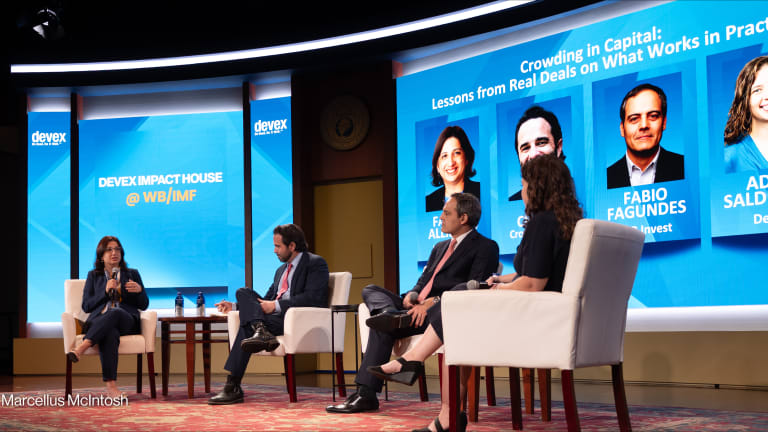
At the Social Capital Markets conference last week, surrounded by thousands of impact investors working in every sector and region of the world, it was clear that the market has advanced and matured rapidly. In the last decade, we have witnessed the impact investing field realize ever-increasing growth of impact assets under management, with a floor estimate of $228 billion in 2017, up from $114 billion in 2016.
But more is needed. The Global Impact Investing Network identifies that “a broader set of investors must be engaged if capital is to reach sufficient scale to match the needs of the people and the planet.”
Just 2 percent of the $200 trillion dollars that comprise the world’s capital markets would be enough to realize the Sustainable Development Goals, with change to spare. Yet this feels far-fetched, due to the constraints institutional investors face, including but certainly not limited to, fiduciary duty, risk-return profiles, and liquidity requirements. To top it off, impact-oriented transactions tend to carry outsized perceived risk, because they often target new and unfamiliar sectors in countries that have a limited investment track record.
Although no silver-bullet solution exists, blended finance is one way impact investors can address these risks and attract additional money and investors toward impact.
Blended finance is the use of catalytic capital from public or philanthropic sources to increase private sector investment in sustainable development. It is an effective risk-sharing arrangement whereby public or philanthropic capital, largely provided by foundations, NGOs, individuals, and development agencies, is used to shrink the distance between real and perceived risks, making it possible to crowd in commercial investors.
More on impact investing:
► At the Vatican, a different type of investing conference
► IFC releases draft impact investment guidelines
► Long Story Short #21: The biggest trends in impact investing
Similar to impact investing, the blended finance space has seen rapid growth in the last few years. Convergence has already identified over $100 billion worth of blended finance transactions, the majority of which have closed in the last decade, spanning sectors from agribusiness to clean energy, education, financial services, and health care.
Often mentioned alongside each other, it is worth clarifying the difference between blended finance and impact investing.
Impact investing is an investment philosophy, where investors are guided by the desire to make a positive impact. In blended finance, on the other hand, it doesn’t matter if all of the investors participating in a given transaction are in it for impact or if some are in it only for returns — or some combination of the two. Blended finance is a tool, a structuring approach, meant to bridge the gaps between different stakeholders’ starting points.
Impact investors are starting to catch wind of the momentum in the blended finance space and have helped draw blended finance into the mainstream. This is clearly the case at SOCAP this year, the largest conference of impact investors, where blended finance was one of the primary themes, with nearly a dozen sessions dedicated to it.
Based on Convergence data, more than 60 percent of historical blended finance deals include at least one impact investor, representing deals that total over $30 billion.
Here’s how impact investors are engaging in blended finance — and what they can bring to the table:
1. Grants for preparation stage funding
Blended finance vehicles are notoriously complex as well as timely and costly to structure. The Rockefeller Foundation’s Zero Gap initiative aims to ease the burden by providing grants and program-related investments into the development of these new and innovative vehicles, recognizing the strong demand for early stage support for research, development, and testing.
2. Guarantees and first loss capital
In addition to providing capital in the earliest stages of a transaction, there are compelling opportunities to provide guarantees and first loss capital within the capital stack.
The Shell Foundation, for example, injected $15 million into the GroFin Africa Fund. This capital took a first loss position and enabled them to attract commercial investors. Similarly, MCE Social Capital, a nonprofit impact investing firm, has developed a novel loan guarantee model where high net worth individuals, foundations, and nonprofits can leverage their balance sheet and act as a guarantor, enabling MCE Social Capital to access increased pools of funds to deploy to microfinance institutions and SMEs.
3. Support pipeline development and capacity building of investees
Not only do impact investors have a unique ability to play a role in transactions deemed too risky by ordinary investors, they also bring years of issue area expertise — as well as a deep knowledge of the needs of their beneficiaries. This market experience makes foundations and NGOs poised to play a key role in supporting pipeline development and building the capacity of investees, and ultimately helping de-risk the investment.
For example, Conservation International plays a critical role in Althelia’s Climate Fund, which focuses on reducing emissions from deforestation and forest degradation through sustainable land use, ecosystem services, and forest carbon assets. In addition to the NGO’s $1.35 million contribution to the fund to help seed the vehicle, it helped build a pipeline of investable projects and actively participates on the fund’s board of experts.
In the last decade, impact investing has grown exponentially, and impact investors have become an increasingly established, respected, and powerful investor subset. Impact investing’s impressive track record and unique ability to attract private capital, combined with blended finance’s ability to accommodate private capital in deals that were previously not investable, is powerful.
The right investors using the right tools is one way we’re going to see new money directed into impact and development at scale.








